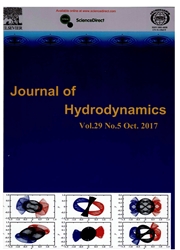

 中文摘要:
中文摘要:
The boundary integral method(BIM) is used to simulate the 3-D gas bubble, generated within the two bubble pulsation periods in proximity to a free surface in an inviscid, incompressible and irrotational flow. The present method is well validated by comparing the calculated shapes of the bubble and the free surface with both the experimental results and the numerical ones obtained by the Axisymmetric BIM code. The expansion, the collapse of the gas bubble and the further evolution of the rebounding non-spherical bubble are simulated. The various variation patterns of the free surface spike and the bubble centroid for different standoff distances, the buoyancy parameters and the strength parameters are obtained to reveal the nonlinear interaction between the bubble and the free surface. The amplitude of the second maximum bubble volume and the four typical patterns of the bubble jet and the free surface spike are examined in the context of the standoff distance. The large buoyancy is used to elevate the spray dome rather than the free surface spike.
 英文摘要:
英文摘要:
The boundary integral method(BIM) is used to simulate the 3-D gas bubble, generated within the two bubble pulsation periods in proximity to a free surface in an inviscid, incompressible and irrotational flow. The present method is well validated by comparing the calculated shapes of the bubble and the free surface with both the experimental results and the numerical ones obtained by the Axisymmetric BIM code. The expansion, the collapse of the gas bubble and the further evolution of the rebounding non-spherical bubble are simulated. The various variation patterns of the free surface spike and the bubble centroid for different standoff distances, the buoyancy parameters and the strength parameters are obtained to reveal the nonlinear interaction between the bubble and the free surface. The amplitude of the second maximum bubble volume and the four typical patterns of the bubble jet and the free surface spike are examined in the context of the standoff distance. The large buoyancy is used to elevate the spray dome rather than the free surface spike.
 同期刊论文项目
同期刊论文项目
 同项目期刊论文
同项目期刊论文
 Nonlinear lifting theory for unsteady WIG in proximity to incident water waves. Part 1: Two-dimensio
Nonlinear lifting theory for unsteady WIG in proximity to incident water waves. Part 1: Two-dimensio Active Thermometry Based DS18B20 Temperature Sensor Network for Offshore Pipeline Scour Monitoring U
Active Thermometry Based DS18B20 Temperature Sensor Network for Offshore Pipeline Scour Monitoring U Experimental investigation of the interaction of multidirectional irregular waves with a large cylin
Experimental investigation of the interaction of multidirectional irregular waves with a large cylin Time-domain numerical and experimental analysis of hydroelastic response of a very large floating st
Time-domain numerical and experimental analysis of hydroelastic response of a very large floating st Research of concrete residual strains monitoring based on WLI and FBG following exposure to freeze-t
Research of concrete residual strains monitoring based on WLI and FBG following exposure to freeze-t Numerical studies on sloshing in rectangular tanks using a tree-based adaptive solver and experiment
Numerical studies on sloshing in rectangular tanks using a tree-based adaptive solver and experiment A numerical study of whole ship structural damage resulting from close-in underwater explosion shock
A numerical study of whole ship structural damage resulting from close-in underwater explosion shock Numerical and experimental analysis of hydroelastic response on a very large floating structure edge
Numerical and experimental analysis of hydroelastic response on a very large floating structure edge Development of a regional coastal management decision-aided system. Part A: Establishment of an auto
Development of a regional coastal management decision-aided system. Part A: Establishment of an auto Vortex shedding from a two-dimensional cylinder beneath a rigid wall and a free surface according to
Vortex shedding from a two-dimensional cylinder beneath a rigid wall and a free surface according to Nonlinear lifting theory for unsteady WIG in proximity to incident water waves. Part 2: Three-dimens
Nonlinear lifting theory for unsteady WIG in proximity to incident water waves. Part 2: Three-dimens Second-order coupling of numerical and physical wave tanks for 2D irregular waves. Part II: Experime
Second-order coupling of numerical and physical wave tanks for 2D irregular waves. Part II: Experime Direct Time Domain Numerical Analysis of Transient Behavior of a VLFS during Unsteady External Loads
Direct Time Domain Numerical Analysis of Transient Behavior of a VLFS during Unsteady External Loads Coupled wind-wave time domain analysis of floating offshore wind turbine based on Computational Flui
Coupled wind-wave time domain analysis of floating offshore wind turbine based on Computational Flui Application of support vector machine for pattern classification of active thermometry-based pipelin
Application of support vector machine for pattern classification of active thermometry-based pipelin Coupled control of the horizontal and vertical plane motions of a semi-submersible platform by a dyn
Coupled control of the horizontal and vertical plane motions of a semi-submersible platform by a dyn BP neural network recognition algorithm for scour monitoring of subsea pipelines based on active the
BP neural network recognition algorithm for scour monitoring of subsea pipelines based on active the Numerical study of transient harbor resonance induced by solitary waves resonance induced by solitar
Numerical study of transient harbor resonance induced by solitary waves resonance induced by solitar Hydroelastic analysis of a very large floating structure edged with a pair of submerged horizontal p
Hydroelastic analysis of a very large floating structure edged with a pair of submerged horizontal p Second-order coupling of numerical and physical wave tanks for 2D irregular waves. Part I: Formulati
Second-order coupling of numerical and physical wave tanks for 2D irregular waves. Part I: Formulati 期刊信息
期刊信息
